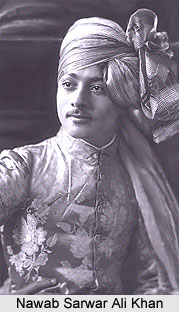 The princely state of Kurwai was amongst the Muslim princely states of India which was under the indirect control of the British Empire in India. The state was administered by the native rulers, also known as Indian princes, under the guidance and protection of the British government. The erstwhile native state covered a total area of 368 sq km in the year 1892 and comprised of a total population of 30,631. Kurwai state, which was appointed as one of the British Indian princely states during the early 19th century, was established by Mohammed Dalal Khan in the year 1730. He was an Afghan who served in the army of the Mughal Empire. The descendants of Mohammed Dalal Khan reigned over the region until the independence of the nation.
The princely state of Kurwai was amongst the Muslim princely states of India which was under the indirect control of the British Empire in India. The state was administered by the native rulers, also known as Indian princes, under the guidance and protection of the British government. The erstwhile native state covered a total area of 368 sq km in the year 1892 and comprised of a total population of 30,631. Kurwai state, which was appointed as one of the British Indian princely states during the early 19th century, was established by Mohammed Dalal Khan in the year 1730. He was an Afghan who served in the army of the Mughal Empire. The descendants of Mohammed Dalal Khan reigned over the region until the independence of the nation.
History of Princely State of Kurwai
The ruling family of the princely state was founded Muhammad Diler Khan in the year 1713. He belonged to the Firuz Khel dynasty of the Orakzai tribe. Muhammad Diler Khan, who was a cousin of Nawab Dost Muhammad Khan, captured the territory of Kurwai and many other adjacent villages. After the death Diler Khan, his eldest surviving son Nawab Izzat Khan, succeeded him and served in the military. He joined forces with the Maratha Dynasty and increased the conquests of his father, and finally served at the 3rd Battle of Panipat in the year 1761. Later he joined Ahmad Shah Abdali and received high commands, titles and territories. He was succeeded by his son Nawab Hurmut Khan. He was detained by the Maratha forces and was imprisoned for 3 years. The Marathas eventually took over his territories and his properties.
Later Hurmut Khan came under the protection of the British East India Company in order to seize his territory back from the Maratha forces. But the British administration annexed the territories along with their other conquests. His descendants reigned over the small state mostly in peace. After the death of Nawab Yaqub Ali Khan, his only son Nawab Sarwar Ali Khan succeeded him at the age of four years. A regency council was appointed under the mother of the Nawab as he was still a minor at the time. Umar Un Nisa, his mother, arranged for Nawab Sarwar Ali Khan to receive advanced education and she also introduced a new system of administration. She set up several welfare institutions, a rural bank for providing loans and distribution of seeds.
 Under the reign of Sarwar Ali Khan, several progressive reforms were implemented for the development of the state. He constructed new buildings, government offices, developed roadways, bridges, police stations, courts, civil hospitals, schools, and powerhouse. The telephone network was also introduced under his supervision. Eventually he established a Legislative Assembly for the purpose of promoting a modern system of administration and governance.
Under the reign of Sarwar Ali Khan, several progressive reforms were implemented for the development of the state. He constructed new buildings, government offices, developed roadways, bridges, police stations, courts, civil hospitals, schools, and powerhouse. The telephone network was also introduced under his supervision. Eventually he established a Legislative Assembly for the purpose of promoting a modern system of administration and governance.
His descendants ruled over the princely state of Kurwai until 15 June 1948, when the Nawab acceded to the newly independent Union of India, also known as the Dominion of India. After the transfer of power, the former Nawab Sarwar Ali Khan remained in India. Later the state was incorporated as apart of the newly formed state of Madhya Bharat and was added to the district of Vidisha. The state of Madhya Bharat was later merged with the modern Indian state of Madhya Pradesh on 1st November 1956. At present, Kurwai is a Nagar Panchayat and a town in Vidisha district in Madhya Pradesh state, India.



















